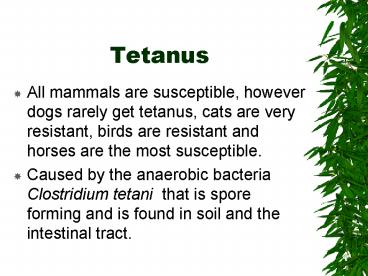Tetanus - PowerPoint PPT Presentation
1 / 8
Title:
Tetanus
Description:
The third eyelid protrudes partially across the eye (normally not seen in healthy animal) ... Fluid therapy to prevent dehydration. Prevention of Tetanus ... – PowerPoint PPT presentation
Number of Views:245
Avg rating:3.0/5.0
Title: Tetanus
1
Tetanus
- All mammals are susceptible, however dogs rarely
get tetanus, cats are very resistant, birds are
resistant and horses are the most susceptible. - Caused by the anaerobic bacteria Clostridium
tetani that is spore forming and is found in
soil and the intestinal tract.
2
- Worldwide occurrence, most frequent in warmer
climates. - Organism enters the body through punctures or
lacerations that create an anaerobic environment
where it can grow. Bacteria remain localized and
as they die they release a powerful neurotoxin
that attacks the nervous system. - Incubation period 10 to 14 days.
3
Symptoms of Tetanus
- Muscle spasms, sometimes violent, following
sudden loud noises or touch. - Incoordination, chewing or grinding of the teeth
(lockjaw), mouth partially open with lips drawn
back. - Erect ears with the tail elevated and stiff in
cattle and horses, assume a sawhorse stance. - Sweating is usually observed.
- The third eyelid protrudes partially across the
eye (normally not seen in healthy animal).
4
- Temperature slightly above normal, but may reach
108 to 110oF just prior to the animal dying. - Animals heart and respiratory rat increase.
- Animal goes down and dies.
5
- Mortality is about 80
- Animals that survive recover in 2 to 6 weeks,
immunity usually does not develop following
recovery.
6
Treatment of Tetanus
- Tranquilization of the animal to prevent injury
during convulsions. - Antibiotics (penicillin preferred) to kill the
organism and stop toxin production. Following
treatment animal becomes sicker due to sudden
release of toxin from dead bacteria, if they
survive this they may recover.
7
- Tetanus antitoxin may be used.
- Fluid therapy to prevent dehydration.
8
Prevention of Tetanus
- Vaccinate with tetanus toxoid (active immunity)
on a yearly basis. - If an animal is thought to have been exposed
(wounds or surgical procedures) give tetanus
antitoxin. - Keep pastures and housing areas clean and free of
objects that might cause a puncture wound.































